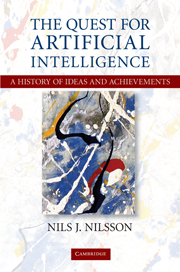Book contents
- Frontmatter
- Contents
- Preface
- PART I BEGINNINGS
- PART II EARLY EXPLORATIONS: 1950S AND 1960S
- 3 Gatherings
- 4 Pattern Recognition
- 5 Early Heuristic Programs
- 6 Semantic Representations
- 7 Natural Language Processing
- 8 1960s' Infrastructure
- PART III EFFLORESCENCE: MID-1960S TO MID-1970S
- PART IV APPLICATIONS AND SPECIALIZATIONS: 1970s TO EARLY 1980s
- PART V “NEW-GENERATION” PROJECT
- PART VI ENTR'ACTE
- PART VII THE GROWING ARMAMENTARIUM: FROM THE 1980s ONWARD
- PART VIII MODERN AI: TODAY AND TOMORROW
- Index
- Plate section
5 - Early Heuristic Programs
Published online by Cambridge University Press: 05 August 2013
- Frontmatter
- Contents
- Preface
- PART I BEGINNINGS
- PART II EARLY EXPLORATIONS: 1950S AND 1960S
- 3 Gatherings
- 4 Pattern Recognition
- 5 Early Heuristic Programs
- 6 Semantic Representations
- 7 Natural Language Processing
- 8 1960s' Infrastructure
- PART III EFFLORESCENCE: MID-1960S TO MID-1970S
- PART IV APPLICATIONS AND SPECIALIZATIONS: 1970s TO EARLY 1980s
- PART V “NEW-GENERATION” PROJECT
- PART VI ENTR'ACTE
- PART VII THE GROWING ARMAMENTARIUM: FROM THE 1980s ONWARD
- PART VIII MODERN AI: TODAY AND TOMORROW
- Index
- Plate section
Summary
The Logic Theorist and Heuristic Search
Just prior to the Dartmouth workshop, Newell, Shaw, and Simon had programmed a version of LT on a computer at the RAND Corporation called the JOHNNIAC (named in honor of John von Neumann). Later papers described how it proved some of the theorems in symbolic logic that were proved by Russell and Whitehead in Volume I of their classic work, Principia Mathematica. LT worked by performing transformations on Russell and Whitehead's five axioms of propositional logic, represented for the computer by “symbol structures,” until a structure was produced that corresponded to the theorem to be proved. Because there are so many different transformations that could be performed, finding the appropriate ones for proving the given theorem involves what computer science people call a “search process.”
To describe how LT and other symbolic AI programs work, I need to explain first what is meant by a “symbol structure” and what is meant by “transforming” them. In a computer, symbols can be combined in lists, such as (A, 7, Q). Symbols and lists of symbols are the simplest kinds of symbol structures. More complex structures are composed of lists of lists of symbols, such as ((B, 3), (A, 7, Q)), and lists of lists of lists of symbols, and so on. Because such lists of lists can be quite complex, they are called “structures.” Computer programs can be written that transform symbol structures into other symbol structures. For example, with a suitable program the structure “(the sum of seven and five)” could be transformed into the structure “(7 + 5),” which could further be transformed into the symbol “12.”
- Type
- Chapter
- Information
- The Quest for Artificial Intelligence , pp. 81 - 95Publisher: Cambridge University PressPrint publication year: 2009



